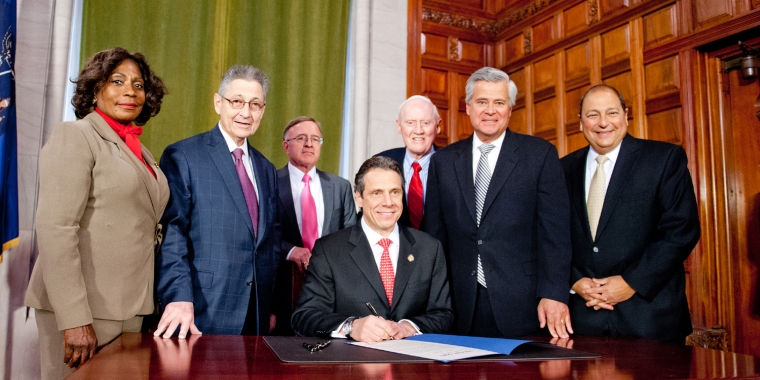
SENATE COMPLETES SECOND CONSECUTIVE EARLY PASSAGE OF STATE BUDGET 2012-13 State Budget Reduces Spending, Does Not Raise Taxes, Creates Jobs
Owen H. Johnson
March 30, 2012
-
ISSUE:
- Budget

SENATE COMPLETES SECOND CONSECUTIVE EARLY PASSAGE OF STATE BUDGET
2012-13 State Budget Reduces Spending, Does Not Raise Taxes, Creates Jobs
For the second consecutive year, the New York State Senate has completed an early passage of the state budget. The 2012-13 state budget achieves the Senate Republicans’ goals of reducing state spending, not raising taxes and creating new private sector jobs. The new state fiscal year begins April 1st.
“The Senate has worked together with the Governor and Assembly to once again pass an early state budget that reduces overall spending, does not increase any taxes or fees, includes mandate relief measures to ease the burden on property taxpayers and makes important investments to create thousands of jobs across the state,” Senate Majority Leader Dean G. Skelos said. “After many years of late budgets and dysfunction, we are restoring people’s faith and confidence that state government is working again. We are addressing the true needs and concerns of taxpayers and pointing our state in a new, positive direction for a brighter future.
“I applaud Governor Cuomo for his leadership, and for working with the Senate and Assembly to deliver bipartisan results,” Senator Skelos said. “The process has worked very well for the people of this state and produced a very positive budget.”
“Between last year’s and this year’s budget, we have now closed $13 billion in deficits without raising any new taxes and fees,” Senator John A. DeFrancisco, Chairman of the Senate Finance Committee, said. “State government is living within the same two percent spending cap as local governments and school districts and we are doing it by controlling spending and reducing the size of government.”
2012-13 STATE BUDGET HIGHLIGHTS
STATE SPENDING GROWTH HELD UNDER TWO PERCENT
> The $132.6 billion spending plan limits all-funds spending growth to 1.9 percent. For the second year in a row, state spending growth is less than the two percent spending cap advocated by Senate Republicans and placed on local government and school budgets.
> The budget eliminates a $2 billion deficit without raising taxes and fees. The budget reduces next year’s projected budget deficit to $950 million. It is the first time in decades that the projected budget gap has been less than a billion dollars.
> The budget makes state government smaller by consolidating a number of state agencies, eliminating or repealing various councils, boards, commissions and committees that are no longer delivering for taxpayers, and providing for other reforms, consolidations and efficiencies to reduce government costs.
NO NEW OR INCREASED TAXES OR FEES
> For the second straight year, the budget does not include any new or increased taxes or fees.
> Just over three months ago, the Senate enacted the Middle Class Tax Cut and Job Creation Plan that reduced tax rates for middle class taxpayers to their lowest levels in more than 50 years.
> Also in December, we repealed the MTA payroll tax for 80 percent of businesses that paid the tax. The MTA payroll tax repeal takes effect April 1, 2012.
> The December tax cut package also cut taxes paid by manufacturing companies by $25 million.
MANDATE RELIEF FOR LOCAL GOVERNMENTS AND PROPERTY TAXPAYERS
> The budget phases in a full state takeover of the county share of growth in Medicaid spending, resulting in $1.7 billion in savings over the next five years for counties and local property taxpayers.
> The state Department of Health will also take over the administration of Medicaid from counties, resulting in additional savings.
> The Senate rejected several proposals in the Executive Budget that would have imposed new mandates, as well as local cost shifts, related to Early Intervention and Special Education Pre-K programs.
> Earlier this month, a new pension reform law was enacted that will generate $80 billion in savings for local governments and school districts over the next 30 years.
> Thirteen cities will be able to receive additional state aid from the Aid and Incentives for Municipalities (AIM) program to help them close budget deficits for the 2012-13 city fiscal year.
> The state will fund $3.4 million to pay for local costs associated with expanding the DNA databank to include people convicted of all crimes.
> Counties will receive $1.2 million from the state to cover a mandated salary increase for District Attorneys that it tied to judicial increases.
JOB CREATION
> Working with the Governor, this budget will create the “NY Works” program to rebuild the state’s roads, highways and bridges and fund other critical infrastructure projects to create thousands of new jobs and get our economy back on track.
> The budget includes $150 million for the second round of Regional Council economic development awards funding to continue the important work we did in last year’s budget to rebuild our regional economies.
> The budget includes $30 million in capital funding for a new round of economic development grants under the NYSUNY 2020 program. When combined with an equal share from SUNY, the University's 60 campuses, excluding the university centers, will compete for three $20 million challenge grants.
EDUCATION
> The budget includes a total of $20.4 billion in aid to education, including an increase in school aid of $805 million - a four percent increase. Much of the increase is targeted for high needs school districts.
> The budget achieves regional balance in school aid and ensures that every region of the state is treated fairly and equitably.
> As a result of the Senate’s efforts, the budget will make school districts eligible to receive state aid to offset costs related to implementing new standards for conducting the Annual Professional Performance Reviews (APPR) for teachers and principals.
> For higher education, $27.8 million was included for three SUNY teaching hospitals.
> Aid to community colleges is increased by $150 per full-time equivalent student for a total of $9.1 million additional funding for CUNY community colleges and $22.1 million for SUNY community colleges.
> The Senate successfully fought to include increased support of $7 million to fund mandates at nonpublic schools.
> Libraries will receive $3.6 million in state aid; also, as a result of the Senate’s earlier efforts, libraries are exempt from the MTA payroll tax, saving them $1.3 million.
HEALTH CARE
> The budget provides $30.6 million to restore the EPIC program. Under the new plan, prescriptions will continue to be paid by Medicare Part D, but EPIC will pay the Medicare Part D co-payment, which will range from $3 to no more than $20. This EPIC restoration was a budget priority for Senate Republicans.
> The budget includes a restoration of $5 million for the Tobacco Control and Prevention Program.
TRANSPORTATION
> The MTA’s five-year capital plan will be fully funded at $22.2 billion and will fund several large-scale projects such as the eastside access for the Long Island Railroad.
> The budget authorizes a capital plan for $4.5 billion in state and federal road and bridge funding for 2012-13, including NY Works transportation projects.
> The budget includes a commitment to getting the MTA Capital Plan and DOT Capital Plan back on the same track to ensure regional parity and fairness.
> Senate Republicans secured a commitment to keep all 11 DOT regional offices open to ensure the unique transportation needs of every region are met.
> The budget provides $39.7 million in Marchiselli aid for local bridge projects and $363.1 million for the CHIPS program for local road improvement projects.
CRIMINAL JUSTICE
> The budget includes $1.5 million to fund grants for targeted drug, violence, crime control, and treatment and prevention programs, $1.2 million for programs to combat domestic violence, and $650,000 for legal services related to domestic violence.
ENVIRONMENTAL PROTECTION
> Funding for the Environmental Protection Fund is maintained at $134 million.
> $89 million is included in the budget to fund major rehabilitation projects and improvements at 48 state parks.
> The budget includes $102 million for repairs to dams and flood control infrastructure. In December, the Legislature approved $50 million to provide flood relief aid to businesses and localities that s
Share this Article or Press Release
Newsroom
Go to NewsroomApril is Organ Donation Awareness Month!
April 23, 2012
April 19, 2012 Bay Shore Summit
April 23, 2012

